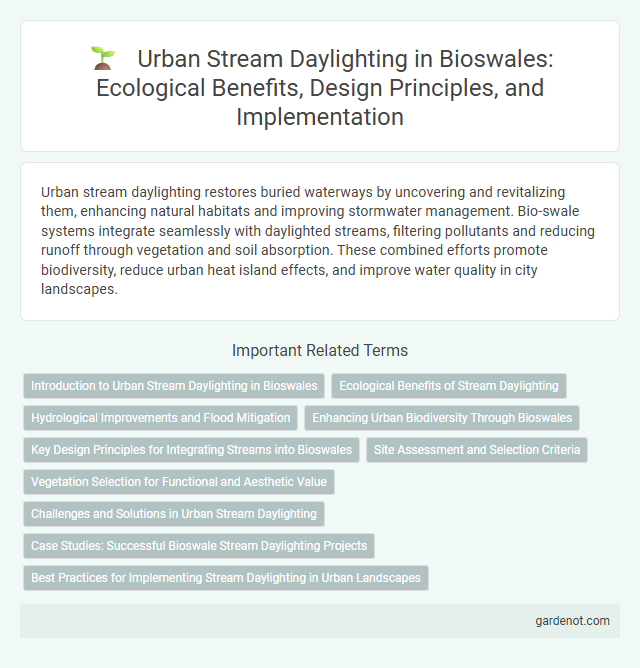Urban stream daylighting restores buried waterways by uncovering and revitalizing them, enhancing natural habitats and improving stormwater management. Bio-swale systems integrate seamlessly with daylighted streams, filtering pollutants and reducing runoff through vegetation and soil absorption. These combined efforts promote biodiversity, reduce urban heat island effects, and improve water quality in city landscapes.
Introduction to Urban Stream Daylighting in Bioswales
Urban stream daylighting involves uncovering and restoring buried or culverted streams to their natural open-air state, enhancing bioswales' effectiveness in urban water management. Exposing these urban streams increases natural filtration, reduces stormwater runoff, and improves water quality by facilitating the bioswale's role in sediment capture and pollutant removal. Integrating daylighted streams creates ecological corridors that support biodiversity and promote sustainable urban drainage systems (SUDS).
Ecological Benefits of Stream Daylighting
Stream daylighting in urban environments restores natural water flow, enhancing habitat connectivity and supporting native biodiversity. Replacing underground pipes with open, vegetated channels improves water quality by facilitating natural filtration and reducing stormwater runoff pollution. This ecological restoration also mitigates urban heat island effects, creating cooler, more resilient ecosystems within city landscapes.
Hydrological Improvements and Flood Mitigation
Urban stream daylighting restores natural water flow by uncovering buried waterways, improving hydrological connectivity and groundwater recharge. This process enhances stormwater infiltration, reduces surface runoff, and mitigates urban flooding risks by increasing channel capacity and slowing flow velocities. Bio-swales integrated alongside daylighted streams further filter pollutants and manage peak stormwater volumes, reinforcing flood resilience in urban environments.
Enhancing Urban Biodiversity Through Bioswales
Urban stream daylighting paired with bioswales significantly enhances urban biodiversity by restoring natural water flow and filtering pollutants through vegetation and soil. Bioswales support diverse plant and microbial communities, creating habitats that attract birds, insects, and aquatic species while improving water quality and reducing runoff. This integrated green infrastructure promotes ecological resilience and reconnects fragmented urban ecosystems.
Key Design Principles for Integrating Streams into Bioswales
Urban stream daylighting enhances bioswale effectiveness by restoring natural hydrology through open channel design, promoting infiltration and pollutant removal. Key design principles include maintaining natural stream morphology, incorporating native riparian vegetation for habitat and bank stabilization, and ensuring connectivity with groundwater systems to support aquatic life. Integrating these elements maximizes water quality improvement and urban ecological resilience within bioswale projects.
Site Assessment and Selection Criteria
Urban stream daylighting projects require thorough site assessment, focusing on hydrology, existing land use, soil type, and infrastructure constraints to restore natural water flow effectively. Key selection criteria include the potential to improve stormwater management, enhance biodiversity, and increase community access to green space while minimizing costs and disruptions. Evaluating historical mapping and current environmental conditions ensures optimal placement of bio-swales to maximize ecological and urban benefits.
Vegetation Selection for Functional and Aesthetic Value
Vegetation selection for urban stream daylighting projects in bio-swales prioritizes native, water-tolerant plants like sedges, rushes, and willows to enhance filtration, erosion control, and habitat creation. Incorporating diverse species with varying root depths and growth forms improves stormwater management and supports pollinators while adding visual interest through seasonal color and texture changes. Selecting plants adapted to local climate and soil conditions ensures long-term sustainability and reduces maintenance in green infrastructure design.
Challenges and Solutions in Urban Stream Daylighting
Urban stream daylighting faces significant challenges such as limited space, infrastructure constraints, and water quality issues in densely populated areas. Effective solutions involve integrating bio-swales to enhance stormwater management, improving infiltration and pollutant removal, while reducing urban runoff velocity. Utilizing green infrastructure design optimizes ecosystem restoration and supports sustainable urban water cycles.
Case Studies: Successful Bioswale Stream Daylighting Projects
Urban stream daylighting projects like Portland's Tanner Creek and Seattle's Thornton Creek demonstrate effective integration of bioswales to restore natural hydrology while enhancing urban green space. These case studies reveal significant reductions in stormwater runoff and pollutant loads, improving water quality and biodiversity through engineered vegetated channels. Data from Seattle indicates a 30% decrease in peak flow rates, highlighting bioswales' capacity to mitigate flooding and support sustainable urban water management.
Best Practices for Implementing Stream Daylighting in Urban Landscapes
Urban stream daylighting enhances ecological restoration, improves water quality, and increases green space connectivity in cities. Best practices include conducting thorough hydrological assessments, employing native vegetation buffers to stabilize banks, and integrating permeable surfaces to reduce runoff. Collaboration among urban planners, ecologists, and community stakeholders ensures sustainable design and long-term maintenance success.
Urban stream daylighting Infographic

 gardenot.com
gardenot.com